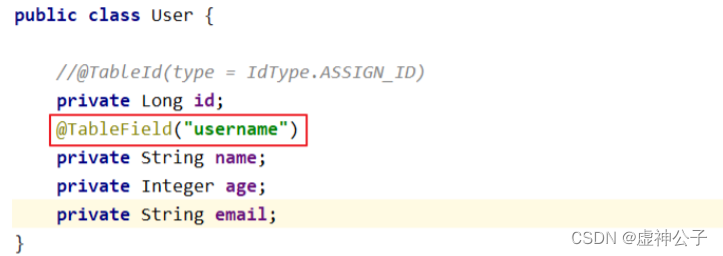MyBatis: MyBatis零基础入门实践
MyBatis-Plus资料:
链接:https://pan.baidu.com/s/16YWDS60ubD4MX70799TzrA?pwd=tdzy
提取码:tdzy
MyBatis-Plus
一、MyBatis-Plus简介
1、简介
MyBatis-Plus(简称 MP)是一个 MyBatis的增强工具,在 MyBatis 的基础上只做增强不做改变,为简化开发、提高效率而生。
愿景
我们的愿景是成为 MyBatis 最好的搭档,就像魂斗罗中的 1P、2P,基友搭配,效率翻倍。
2、特性
无侵入:只做增强不做改变,引入它不会对现有工程产生影响,如丝般顺滑
损耗小:启动即会自动注入基本 CURD,性能基本无损耗,直接面向对象操作
强大的 CRUD 操作:内置通用 Mapper、通用 Service,仅仅通过少量配置即可实现单表大部分CRUD 操作,更有强大的条件构造器,满足各类使用需求
支持 Lambda 形式调用:通过 Lambda 表达式,方便的编写各类查询条件,无需再担心字段写错
支持主键自动生成:支持多达 4 种主键策略(内含分布式唯一 ID 生成器 - Sequence),可自由配置,完美解决主键问题
支持 ActiveRecord 模式:支持 ActiveRecord 形式调用,实体类只需继承 Model 类即可进行强大的 CRUD 操作
支持自定义全局通用操作:支持全局通用方法注入( Write once, use anywhere )
内置代码生成器:采用代码或者 Maven 插件可快速生成 Mapper 、 Model 、 Service 、Controller 层代码,支持模板引擎,更有超多自定义配置等您来使用
内置分页插件:基于 MyBatis 物理分页,开发者无需关心具体操作,配置好插件之后,写分页等同于普通 List 查询
分页插件支持多种数据库:支持 MySQL、MariaDB、Oracle、DB2、H2、HSQL、SQLite、Postgre、SQLServer 等多种数据库
内置性能分析插件:可输出 SQL 语句以及其执行时间,建议开发测试时启用该功能,能快速揪出慢查询
内置全局拦截插件:提供全表 delete 、 update 操作智能分析阻断,也可自定义拦截规则,预防误操作
3、支持数据库
任何能使用MyBatis进行 CRUD, 并且支持标准 SQL 的数据库,具体支持情况如下
MySQL,Oracle,DB2,H2,HSQL,SQLite,PostgreSQL,SQLServer,Phoenix,Gauss ,ClickHouse,Sybase,OceanBase,Firebird,Cubrid,Goldilocks,csiidb
达梦数据库,虚谷数据库,人大金仓数据库,南大通用(华库)数据库,南大通用数据库,神通数据库,瀚高数据库
4、框架结构
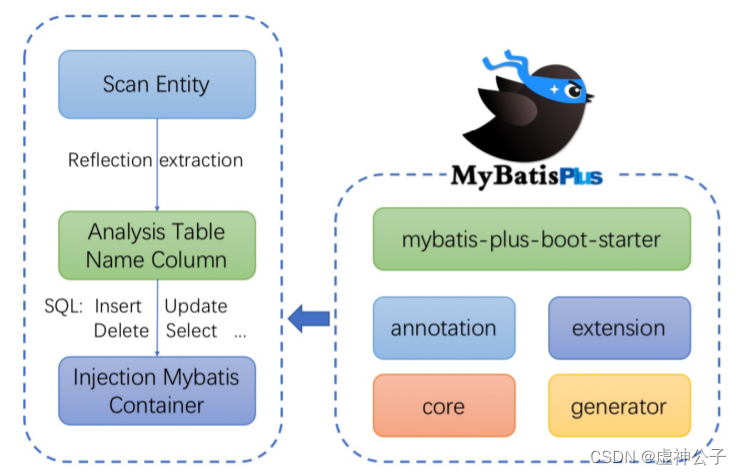
5、代码及文档地址
官方地址: http://mp.baomidou.com
代码发布地址:
Github: https://github.com/baomidou/mybatis-plus
Gitee: https://gitee.com/baomidou/mybatis-plus
文档发布地址: https://baomidou.com/pages/24112f
二、入门案例
1、开发环境
IDE:idea 2020.3
JDK:JDK8+
构建工具:maven 3.6.1
MySQL版本:MySQL 5.7
Spring Boot:2.6.3
MyBatis-Plus:3.5.1
2、创建数据库及表
a>创建表
CREATE DATABASE `mybatis_plus` /*!40100 DEFAULT CHARACTER SET utf8mb4 */;
use `mybatis_plus`;
CREATE TABLE `user` (
`id` bigint(20) NOT NULL COMMENT '主键ID',
`name` varchar(30) DEFAULT NULL COMMENT '姓名',
`age` int(11) DEFAULT NULL COMMENT '年龄',
`email` varchar(50) DEFAULT NULL COMMENT '邮箱',
PRIMARY KEY (`id`)
) ENGINE=InnoDB DEFAULT CHARSET=utf8;
b>添加数据
INSERT INTO user (id, name, age, email) VALUES
(1, 'Jone', 18, 'test1@baomidou.com'),
(2, 'Jack', 20, 'test2@baomidou.com'),
(3, 'Tom', 28, 'test3@baomidou.com'),
(4, 'Sandy', 21, 'test4@baomidou.com'),
(5, 'Billie', 24, 'test5@baomidou.com');
3、创建Spring Boot工程
a>初始化工程
使用 Spring Initializr 快速初始化一个 Spring Boot 工程
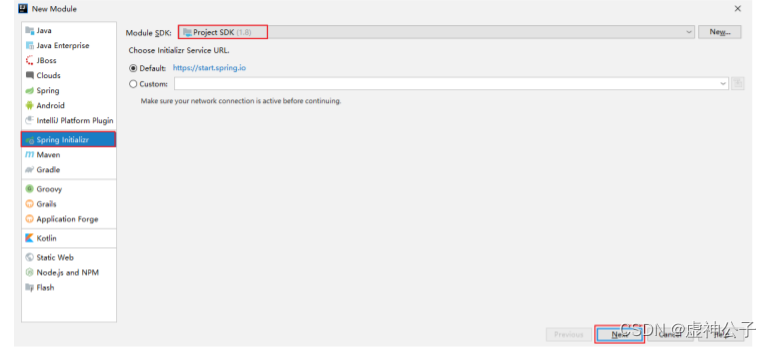
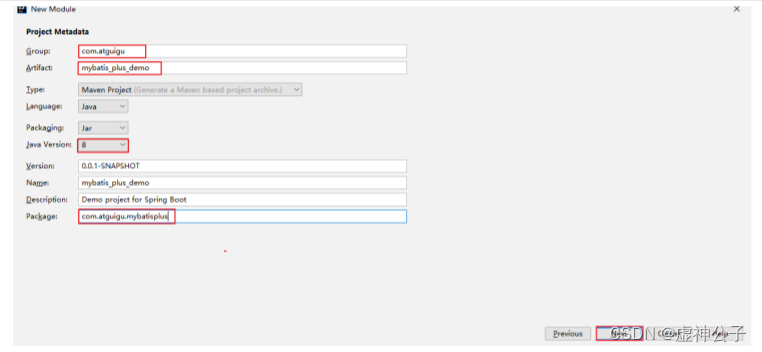


b>引入依赖
<dependencies>
<dependency>
<groupId>org.springframework.boot</groupId>
<artifactId>spring-boot-starter</artifactId>
</dependency>
<dependency>
<groupId>org.springframework.boot</groupId>
<artifactId>spring-boot-starter-test</artifactId>
<scope>test</scope>
</dependency>
<!--mybatis-plus启动器-->
<dependency>
<groupId>com.baomidou</groupId>
<artifactId>mybatis-plus-boot-starter</artifactId>
<version>3.5.1</version>
</dependency>
<!--lombok用于简化实体类开发-->
<dependency>
<groupId>org.projectlombok</groupId>
<artifactId>lombok</artifactId>
<optional>true</optional>
</dependency>
<!--mysql驱动-->
<dependency>
<groupId>mysql</groupId>
<artifactId>mysql-connector-java</artifactId>
<scope>runtime</scope>
</dependency>
<dependency>
<groupId>com.baomidou</groupId>
<artifactId>mybatis-plus-generator</artifactId>
<version>3.5.1</version>
</dependency>
<dependency>
<groupId>org.springframework.boot</groupId>
<artifactId>spring-boot-starter-web</artifactId>
<version>RELEASE</version>
<scope>compile</scope>
</dependency>
</dependencies>
c>idea中安装lombok插件
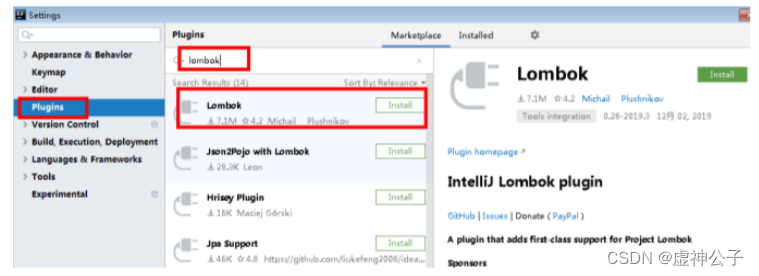
4、编写代码
a>配置application.yml
spring:
# 配置数据源信息
datasource:
# 配置数据源类型
type: com.zaxxer.hikari.HikariDataSource
# 配置连接数据库的各个信息
driver-class-name: com.mysql.cj.jdbc.Driver
url: jdbc:mysql://localhost:3306/mybatis_plus1?characterEncoding=utf-8&userSSL=false
# url: jdbc:mysql://localhost:3306/mybatis_plus?serverTimezone=GMT%2B8&useUnicode=true&characterEncoding=UTF-8&useSSL=false
username: root
password: root
注意:
1、驱动类driver-class-name
spring boot 2.0(内置jdbc5驱动),驱动类使用:
driver-class-name: com.mysql.jdbc.Driver
spring boot 2.1及以上(内置jdbc8驱动),驱动类使用:
driver-class-name: com.mysql.cj.jdbc.Driver
否则运行测试用例的时候会有 WARN 信息
2、连接地址url
MySQL5.7版本的url:
jdbc:mysql://localhost:3306/mybatis_plus?characterEncoding=utf-8&useSSL=false
MySQL8.0版本的url:
jdbc:mysql://localhost:3306/mybatis_plus?
serverTimezone=GMT%2B8&characterEncoding=utf-8&useSSL=false
否则运行测试用例报告如下错误:
java.sql.SQLException: The server time zone value ‘Öйú±ê׼ʱ¼ä’ is unrecognized or represents more
b>启动类
在Spring Boot启动类中添加@MapperScan注解,扫描mapper包
@SpringBootApplication
@MapperScan("com/xusheng/mybatisplus/mapper")
public class MybatisplusApplication {
public static void main(String[] args) {
SpringApplication.run(MybatisplusApplication.class, args);
}
}
c>添加实体
@Data //lombok注解
public class User {
private Long id;
private String name;
private Integer age;
private String email;
}
User类编译之后的结果:
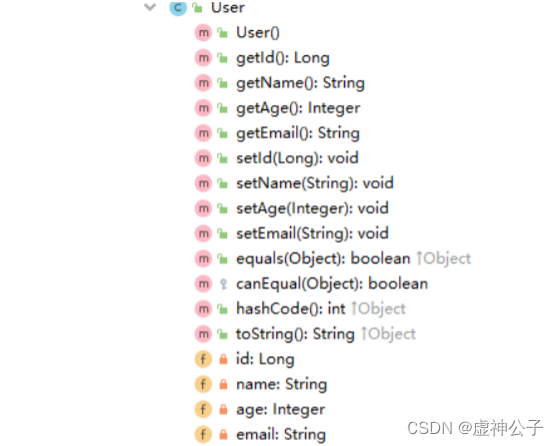
d>添加mapper
BaseMapper是MyBatis-Plus提供的模板mapper,其中包含了基本的CRUD方法,泛型为操作的实体类型
@Repository
public interface UserMapper extends BaseMapper<User> {
}
e>测试
@SpringBootTest
public class MyBatisPlusTest {
@Autowired
private UserMapper userMapper;
@Test
public void testSelectList(){
//通过条件构造器查询一个list集合,若没有条件,则可以设置null为参数
//selectList()根据MP内置的条件构造器查询一个list集合,null表示没有条件,即查询所有
//userMapper.selectList(null).forEach(System.out::println);
List<User> list = userMapper.selectList(null);
list.forEach(System.out::println);
}
}
结果:

注意:
IDEA在 userMapper 处报错,因为找不到注入的对象,因为类是动态创建的,但是程序可以正确的执行。
为了避免报错,可以在mapper接口上添加 @Repository 注解
f>添加日志
在application.yml中配置日志输出
mybatis-plus:
configuration:
log-impl: org.apache.ibatis.logging.stdout.StdOutImpl
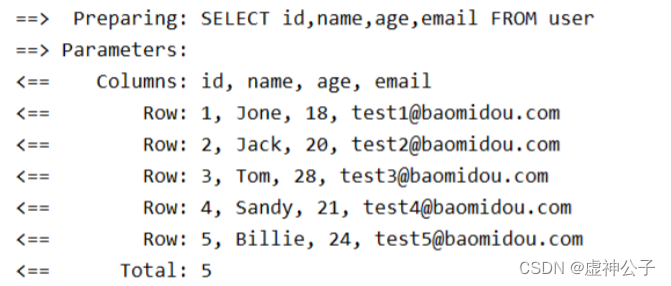
三、基本CRUD
1、BaseMapper
MyBatis-Plus中的基本CRUD在内置的BaseMapper中都已得到了实现,我们可以直接使用,接口如下:
/*
* Copyright (c) 2011-2022, baomidou ([email protected]).
*
* Licensed under the Apache License, Version 2.0 (the "License");
* you may not use this file except in compliance with the License.
* You may obtain a copy of the License at
*
* http://www.apache.org/licenses/LICENSE-2.0
*
* Unless required by applicable law or agreed to in writing, software
* distributed under the License is distributed on an "AS IS" BASIS,
* WITHOUT WARRANTIES OR CONDITIONS OF ANY KIND, either express or implied.
* See the License for the specific language governing permissions and
* limitations under the License.
*/
package com.baomidou.mybatisplus.core.mapper;
import com.baomidou.mybatisplus.core.conditions.Wrapper;
import com.baomidou.mybatisplus.core.metadata.IPage;
import com.baomidou.mybatisplus.core.toolkit.CollectionUtils;
import com.baomidou.mybatisplus.core.toolkit.Constants;
import com.baomidou.mybatisplus.core.toolkit.ExceptionUtils;
import org.apache.ibatis.annotations.Param;
import java.io.Serializable;
import java.util.Collection;
import java.util.List;
import java.util.Map;
/**
* Mapper 继承该接口后,无需编写 mapper.xml 文件,即可获得CRUD功能
* <p>这个 Mapper 支持 id 泛型</p>
*
* @author hubin
* @since 2016-01-23
*/
public interface BaseMapper<T> extends Mapper<T> {
/**
* 插入一条记录
*
* @param entity 实体对象
*/
int insert(T entity);
/**
* 根据 ID 删除
*
* @param id 主键ID
*/
int deleteById(Serializable id);
/**
* 根据实体(ID)删除
*
* @param entity 实体对象
* @since 3.4.4
*/
int deleteById(T entity);
/**
* 根据 columnMap 条件,删除记录
*
* @param columnMap 表字段 map 对象
*/
int deleteByMap(@Param(Constants.COLUMN_MAP) Map<String, Object> columnMap);
/**
* 根据 entity 条件,删除记录
*
* @param queryWrapper 实体对象封装操作类(可以为 null,里面的 entity 用于生成 where 语句)
*/
int delete(@Param(Constants.WRAPPER) Wrapper<T> queryWrapper);
/**
* 删除(根据ID或实体 批量删除)
*
* @param idList 主键ID列表或实体列表(不能为 null 以及 empty)
*/
int deleteBatchIds(@Param(Constants.COLLECTION) Collection<?> idList);
/**
* 根据 ID 修改
*
* @param entity 实体对象
*/
int updateById(@Param(Constants.ENTITY) T entity);
/**
* 根据 whereEntity 条件,更新记录
*
* @param entity 实体对象 (set 条件值,可以为 null)
* @param updateWrapper 实体对象封装操作类(可以为 null,里面的 entity 用于生成 where 语句)
*/
int update(@Param(Constants.ENTITY) T entity, @Param(Constants.WRAPPER) Wrapper<T> updateWrapper);
/**
* 根据 ID 查询
*
* @param id 主键ID
*/
T selectById(Serializable id);
/**
* 查询(根据ID 批量查询)
*
* @param idList 主键ID列表(不能为 null 以及 empty)
*/
List<T> selectBatchIds(@Param(Constants.COLLECTION) Collection<? extends Serializable> idList);
/**
* 查询(根据 columnMap 条件)
*
* @param columnMap 表字段 map 对象
*/
List<T> selectByMap(@Param(Constants.COLUMN_MAP) Map<String, Object> columnMap);
/**
* 根据 entity 条件,查询一条记录
* <p>查询一条记录,例如 qw.last("limit 1") 限制取一条记录, 注意:多条数据会报异常</p>
*
* @param queryWrapper 实体对象封装操作类(可以为 null)
*/
default T selectOne(@Param(Constants.WRAPPER) Wrapper<T> queryWrapper) {
List<T> ts = this.selectList(queryWrapper);
if (CollectionUtils.isNotEmpty(ts)) {
if (ts.size() != 1) {
throw ExceptionUtils.mpe("One record is expected, but the query result is multiple records");
}
return ts.get(0);
}
return null;
}
/**
* 根据 Wrapper 条件,判断是否存在记录
*
* @param queryWrapper 实体对象封装操作类
* @return
*/
default boolean exists(Wrapper<T> queryWrapper) {
Long count = this.selectCount(queryWrapper);
return null != count && count > 0;
}
/**
* 根据 Wrapper 条件,查询总记录数
*
* @param queryWrapper 实体对象封装操作类(可以为 null)
*/
Long selectCount(@Param(Constants.WRAPPER) Wrapper<T> queryWrapper);
/**
* 根据 entity 条件,查询全部记录
*
* @param queryWrapper 实体对象封装操作类(可以为 null)
*/
List<T> selectList(@Param(Constants.WRAPPER) Wrapper<T> queryWrapper);
/**
* 根据 Wrapper 条件,查询全部记录
*
* @param queryWrapper 实体对象封装操作类(可以为 null)
*/
List<Map<String, Object>> selectMaps(@Param(Constants.WRAPPER) Wrapper<T> queryWrapper);
/**
* 根据 Wrapper 条件,查询全部记录
* <p>注意: 只返回第一个字段的值</p>
*
* @param queryWrapper 实体对象封装操作类(可以为 null)
*/
List<Object> selectObjs(@Param(Constants.WRAPPER) Wrapper<T> queryWrapper);
/**
* 根据 entity 条件,查询全部记录(并翻页)
*
* @param page 分页查询条件(可以为 RowBounds.DEFAULT)
* @param queryWrapper 实体对象封装操作类(可以为 null)
*/
<P extends IPage<T>> P selectPage(P page, @Param(Constants.WRAPPER) Wrapper<T> queryWrapper);
/**
* 根据 Wrapper 条件,查询全部记录(并翻页)
*
* @param page 分页查询条件
* @param queryWrapper 实体对象封装操作类
*/
<P extends IPage<Map<String, Object>>> P selectMapsPage(P page, @Param(Constants.WRAPPER) Wrapper<T> queryWrapper);
}
2、插入
@Test
public void testInsert(){
//实现新增用户信息
//INSERT INTO user ( id, name, age, email ) VALUES ( ?, ?, ?, ? )
User user = new User();
user.setId(100L);
user.setName("xusheng");
user.setAge(23);
user.setEmail("[email protected]");
int result = userMapper.insert(user);
System.out.println("result:"+result);
System.out.println("id:"+user.getId());
}
MyBatis-Plus在实现插入数据时,会默认基于雪花算法的策略生成id
3、删除
a>通过id删除记录
@Test
public void testDeleteById(){
//通过id删除用户信息
//DELETE FROM user WHERE id=?
int result = userMapper.deleteById(1475754982694199298L);
System.out.println("受影响行数:"+result);
}
b>通过id批量删除记录
@Test
public void testDeleteBatchIds(){
//通过多个id批量删除
//DELETE FROM user WHERE id IN ( ? , ? , ? )
List<Long> idList = Arrays.asList(1L, 2L, 3L);
int result = userMapper.deleteBatchIds(idList);
System.out.println("受影响行数:"+result);
}
c>通过map条件删除记录
@Test
public void testDeleteByMap(){
//根据map集合中所设置的条件删除记录
//DELETE FROM user WHERE name = ? AND age = ?
Map<String, Object> map = new HashMap<>();
map.put("age", 23);
map.put("name", "张三");
int result = userMapper.deleteByMap(map);
System.out.println("受影响行数:"+result);
}
4、修改
@Test
public void testUpdate(){
//修改用户信息
//UPDATE user SET name=?, email=? WHERE id=?
User user = new User();
user.setId(4L);
user.setName("李四");
user.setEmail("[email protected]");
int result = userMapper.updateById(user);
System.out.println("result:"+result);
}
5、查询
a>根据id查询用户信息
@Test
public void testSelectById(){
//根据id查询用户信息
//SELECT id,name,age,email FROM user WHERE id=?
User user = userMapper.selectById(4L);
System.out.println(user);
}
b>根据多个id查询多个用户信息
@Test
public void testSelectBatchIds(){
//根据多个id查询多个用户信息
//SELECT id,name,age,email FROM user WHERE id IN ( ? , ? )
List<Long> idList = Arrays.asList(4L, 5L);
List<User> list = userMapper.selectBatchIds(idList);
list.forEach(System.out::println);
}
c>通过map条件查询用户信息
@Test
public void testSelectByMap(){
//通过map条件查询用户信息
//SELECT id,name,age,email FROM user WHERE name = ? AND age = ?
Map<String, Object> map = new HashMap<>();
map.put("age", 22);
map.put("name", "admin");
List<User> list = userMapper.selectByMap(map);
list.forEach(System.out::println);
}
d>查询所有数据
@Test
public void testSelectList(){
//查询所有用户信息
//SELECT id,name,age,email FROM user
List<User> list = userMapper.selectList(null);
list.forEach(System.out::println);
}
通过观察BaseMapper中的方法,大多方法中都有Wrapper类型的形参,此为条件构造器,可针对于SQL语句设置不同的条件,若没有条件,则可以为该形参赋值null,即查询(删除/修改)所有数据
6、通用Service
说明:
通用 Service CRUD 封装IService接口,进一步封装 CRUD 采用 get 查询单行 remove 删除 list 查询集合 page 分页 前缀命名方式区分 Mapper 层避免混淆,泛型 T 为任意实体对象
建议如果存在自定义通用 Service 方法的可能,请创建自己的 IBaseService 继承Mybatis-Plus 提供的基类
官网地址:https://baomidou.com/pages/49cc81/#service-crud-%E6%8E%A5%E5%8F%A3
a>IService
MyBatis-Plus中有一个接口 IService和其实现类 ServiceImpl,封装了常见的业务层逻辑,详情查看源码IService和ServiceImpl
b>创建Service接口和实现类
package com.xusheng.mybatisplus.service;
import com.xusheng.mybatisplus.entity.User;
import com.baomidou.mybatisplus.extension.service.IService;
/**
* <p>
* 服务类
* </p>
*UserService继承IService模板提供的基础功能
* @author xusheng
* @since 2023-04-01
*/
public interface UserService extends IService<User> {
}
package com.xusheng.mybatisplus.service.impl;
import com.xusheng.mybatisplus.entity.User;
import com.xusheng.mybatisplus.mapper.UserMapper;
import com.xusheng.mybatisplus.service.IUserService;
import com.baomidou.mybatisplus.extension.service.impl.ServiceImpl;
import org.springframework.stereotype.Service;
/**
* <p>
* 服务实现类
* </p>
*ServiceImpl实现了IService,提供了IService中基础功能的实现
* * 若ServiceImpl无法满足业务需求,则可以使用自定的UserService定义方法,并在实现类中实现
* @author xusheng
* @since 2023-04-01
*/
@Service
public class UserServiceImpl extends ServiceImpl<UserMapper, User> implements UserService {
}
c>测试查询记录数
package com.xusheng.mybatisplus;
import com.xusheng.mybatisplus.entity.User;
import com.xusheng.mybatisplus.service.UserService;
import com.xusheng.mybatisplus.service.impl.UserServiceImpl;
import org.junit.jupiter.api.Test;
import org.springframework.beans.factory.annotation.Autowired;
import org.springframework.boot.test.context.SpringBootTest;
import java.util.ArrayList;
import java.util.List;
@SpringBootTest
public class MyBatisPlusServiceTest {
@Autowired
private UserService userService;
@Test
public void testGetCount(){
//查询总记录数
//SELECT COUNT( * ) FROM user
long count = userService.count();
System.out.println("总记录数:"+count);
}
}
d>测试批量插入
@Test
public void testInsertMore(){
//批量添加
// SQL长度有限制,海量数据插入单条SQL无法实行,
// 因此MP将批量插入放在了通用Service中实现,而不是通用Mapper
//INSERT INTO user ( id, name, age ) VALUES ( ?, ?, ? )
ArrayList<User> list = new ArrayList<>();
for (int i = 1; i < 10; i++) {
User user = new User();
user.setName("ybc"+i);
user.setAge(20+i);
list.add(user);
}
boolean b = userService.saveBatch(list);
System.out.println(b);
}
四、常用注解
1、@TableName
经过以上的测试,在使用MyBatis-Plus实现基本的CRUD时,我们并没有指定要操作的表,只是在Mapper接口继承BaseMapper时,设置了泛型User,而操作的表为user表
由此得出结论,MyBatis-Plus在确定操作的表时,由BaseMapper的泛型决定,即实体类型决定,且默认操作的表名和实体类型的类名一致
a>问题
若实体类类型的类名和要操作的表的表名不一致,会出现什么问题?
我们将表user更名为t_user,测试查询功能
程序抛出异常,Table ‘mybatis_plus.user’ doesn’t exist,因为现在的表名为t_user,而默认操作的表名和实体类型的类名一致,即user表
b>通过@TableName解决问题
在实体类类型上添加@TableName(“t_user”),标识实体类对应的表,即可成功执行SQL语句
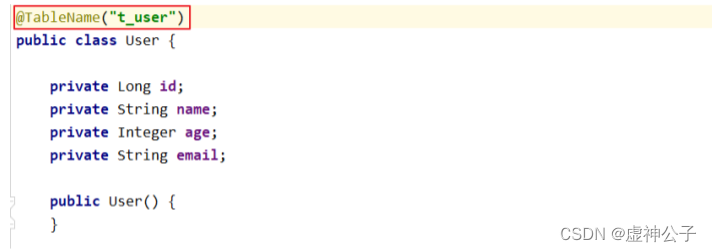
c>通过全局配置解决问题
在开发的过程中,我们经常遇到以上的问题,即实体类所对应的表都有固定的前缀,例如t_或tbl_
此时,可以使用MyBatis-Plus提供的全局配置,为实体类所对应的表名设置默认的前缀,那么就不需要在每个实体类上通过@TableName标识实体类对应的表
mybatis-plus:
configuration:
log-impl: org.apache.ibatis.logging.stdout.StdOutImpl
# 设置MyBatis-Plus的全局配置
global-config:
db-config:
# 设置实体类所对应的表的统一前缀
table-prefix: t_
2、@TableId
经过以上的测试,MyBatis-Plus在实现CRUD时,会默认将id作为主键列,并在插入数据时,默认基于雪花算法的策略生成id
a>问题
若实体类和表中表示主键的不是id,而是其他字段,例如uid,MyBatis-Plus会自动识别uid为主键列吗?
我们实体类中的属性id改为uid,将表中的字段id也改为uid,测试添加功能
程序抛出异常,Field ‘uid’ doesn’t have a default value,说明MyBatis-Plus没有将uid作为主键赋值
b>通过@TableId解决问题
在实体类中uid属性上通过@TableId将其标识为主键,即可成功执行SQL语句
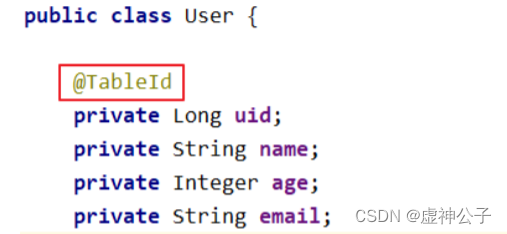
c>@TableId的value属性
若实体类中主键对应的属性为id,而表中表示主键的字段为uid,此时若只在属性id上添加注解@TableId,则抛出异常Unknown column ‘id’ in ‘field list’,即MyBatis-Plus仍然会将id作为表的主键操作,而表中表示主键的是字段uid
此时需要通过@TableId注解的value属性,指定表中的主键字段,@TableId(“uid”)或
@TableId(value=“uid”)
d>@TableId的type属性
type属性用来定义主键策略
常用的主键策略:

配置全局主键策略:
mybatis-plus:
configuration:
log-impl: org.apache.ibatis.logging.stdout.StdOutImpl
# 设置MyBatis-Plus的全局配置
global-config:
db-config:
# 设置实体类所对应的表的统一前缀
table-prefix: t_
# 设置统一的主键生成策略
id-type: auto
e>雪花算法
背景
需要选择合适的方案去应对数据规模的增长,以应对逐渐增长的访问压力和数据量。
数据库的扩展方式主要包括:业务分库、主从复制,数据库分表。
数据库分表
将不同业务数据分散存储到不同的数据库服务器,能够支撑百万甚至千万用户规模的业务,但如果业务继续发展,同一业务的单表数据也会达到单台数据库服务器的处理瓶颈。例如,淘宝的几亿用户数据,如果全部存放在一台数据库服务器的一张表中,肯定是无法满足性能要求的,此时就需要对单表数据进行拆分。
单表数据拆分有两种方式:垂直分表和水平分表。示意图如下:
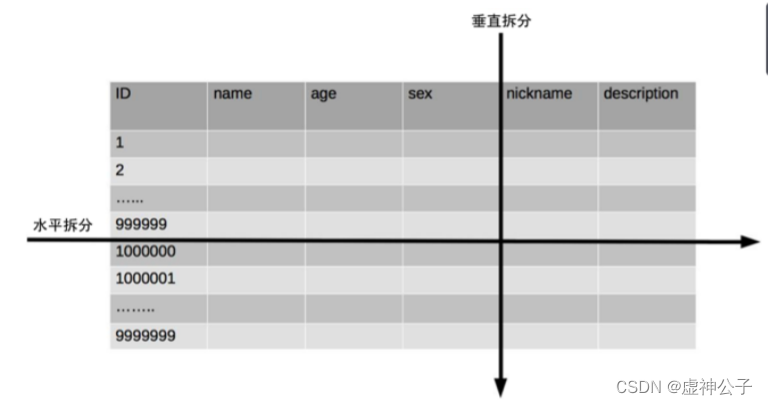
垂直分表
垂直分表适合将表中某些不常用且占了大量空间的列拆分出去。
例如,前面示意图中的 nickname 和 description 字段,假设我们是一个婚恋网站,用户在筛选其他用户的时候,主要是用 age 和 sex 两个字段进行查询,而 nickname 和 description 两个字段主要用于展示,一般不会在业务查询中用到。description 本身又比较长,因此我们可以将这两个字段独立到另外一张表中,这样在查询 age 和 sex 时,就能带来一定的性能提升。
水平分表
水平分表适合表行数特别大的表,有的公司要求单表行数超过 5000 万就必须进行分表,这个数字可以作为参考,但并不是绝对标准,关键还是要看表的访问性能。对于一些比较复杂的表,可能超过 1000万就要分表了;而对于一些简单的表,即使存储数据超过 1 亿行,也可以不分表。
但不管怎样,当看到表的数据量达到千万级别时,作为架构师就要警觉起来,因为这很可能是架构的性能瓶颈或者隐患。
水平分表相比垂直分表,会引入更多的复杂性,例如要求全局唯一的数据id该如何处理
主键自增
①以最常见的用户 ID 为例,可以按照 1000000 的范围大小进行分段,1 ~ 999999 放到表 1中,
1000000 ~ 1999999 放到表2中,以此类推。
②复杂点:分段大小的选取。分段太小会导致切分后子表数量过多,增加维护复杂度;分段太大可能会
导致单表依然存在性能问题,一般建议分段大小在 100 万至 2000 万之间,具体需要根据业务选取合适
的分段大小。
③优点:可以随着数据的增加平滑地扩充新的表。例如,现在的用户是 100 万,如果增加到 1000 万,
只需要增加新的表就可以了,原有的数据不需要动。
④缺点:分布不均匀。假如按照 1000 万来进行分表,有可能某个分段实际存储的数据量只有 1 条,而
另外一个分段实际存储的数据量有 1000 万条。
取模
①同样以用户 ID 为例,假如我们一开始就规划了 10 个数据库表,可以简单地用 user_id % 10 的值来
表示数据所属的数据库表编号,ID 为 985 的用户放到编号为 5 的子表中,ID 为 10086 的用户放到编号
为 6 的子表中。
②复杂点:初始表数量的确定。表数量太多维护比较麻烦,表数量太少又可能导致单表性能存在问题。
③优点:表分布比较均匀。
④缺点:扩充新的表很麻烦,所有数据都要重分布。
雪花算法
雪花算法是由Twitter公布的分布式主键生成算法,它能够保证不同表的主键的不重复性,以及相同表的
主键的有序性。
①核心思想:
长度共64bit(一个long型)。
首先是一个符号位,1bit标识,由于long基本类型在Java中是带符号的,最高位是符号位,正数是0,负
数是1,所以id一般是正数,最高位是0。
41bit时间截(毫秒级),存储的是时间截的差值(当前时间截 - 开始时间截),结果约等于69.73年。
10bit作为机器的ID(5个bit是数据中心,5个bit的机器ID,可以部署在1024个节点)。
12bit作为毫秒内的流水号(意味着每个节点在每毫秒可以产生 4096 个 ID)。

②优点:整体上按照时间自增排序,并且整个分布式系统内不会产生ID碰撞,并且效率较高。
3、@TableField
经过以上的测试,我们可以发现,MyBatis-Plus在执行SQL语句时,要保证实体类中的属性名和表中的字段名一致
如果实体类中的属性名和字段名不一致的情况,会出现什么问题呢?
a>情况1
若实体类中的属性使用的是驼峰命名风格,而表中的字段使用的是下划线命名风格
例如实体类属性userName,表中字段user_name
此时MyBatis-Plus会自动将下划线命名风格转化为驼峰命名风格
相当于在MyBatis中配置
b>情况2
若实体类中的属性和表中的字段不满足情况1
例如实体类属性name,表中字段username
此时需要在实体类属性上使用@TableField(“username”)设置属性所对应的字段名
4、@TableLogic
a>逻辑删除
物理删除:真实删除,将对应数据从数据库中删除,之后查询不到此条被删除的数据
逻辑删除:假删除,将对应数据中代表是否被删除字段的状态修改为“被删除状态”,之后在数据库中仍旧能看到此条数据记录
使用场景:可以进行数据恢复
b>实现逻辑删除
step1:数据库中创建逻辑删除状态列,设置默认值为0
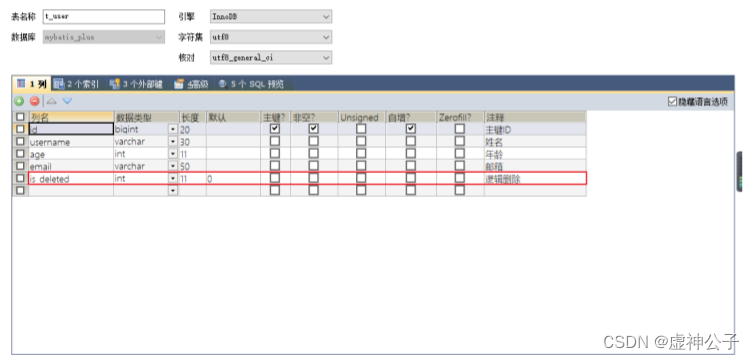
step2:实体类中添加逻辑删除属性

step3:测试
测试删除功能,真正执行的是修改 UPDATE t_user SET is_deleted=1 WHERE id=? AND
is_deleted=0 测试查询功能,被逻辑删除的数据默认不会被查询 SELECT id,username AS
name,age,email,is_deleted FROM t_user WHERE is_deleted=0
五、条件构造器和常用接口
1、wapper介绍

Wrapper : 条件构造抽象类,最顶端父类
AbstractWrapper : 用于查询条件封装,生成 sql 的 where 条件
QueryWrapper : 查询条件封装
UpdateWrapper : Update 条件封装
AbstractLambdaWrapper : 使用Lambda 语法
LambdaQueryWrapper :用于Lambda语法使用的查询Wrapper
LambdaUpdateWrapper : Lambda 更新封装Wrapper
2、QueryWrapper
a>例1:组装查询条件
package com.xusheng.mybatisplus;
import com.baomidou.mybatisplus.core.conditions.query.LambdaQueryWrapper;
import com.baomidou.mybatisplus.core.conditions.query.QueryWrapper;
import com.baomidou.mybatisplus.core.conditions.update.LambdaUpdateWrapper;
import com.baomidou.mybatisplus.core.conditions.update.UpdateWrapper;
import com.baomidou.mybatisplus.core.toolkit.StringUtils;
import com.xusheng.mybatisplus.entity.User;
import com.xusheng.mybatisplus.mapper.UserMapper;
import org.junit.jupiter.api.Test;
import org.springframework.beans.factory.annotation.Autowired;
import org.springframework.boot.test.context.SpringBootTest;
import java.util.List;
import java.util.Map;
@SpringBootTest
public class MyBatisPlusWrapperTest {
@Autowired
private UserMapper userMapper;
@Test
public void test01(){
//查询用户名包含a,年龄在20到30之间,邮箱信息不为null的用户信息
//SELECT uid AS id,user_name AS name,age,email,is_deleted FROM t_user WHERE is_deleted=0 AND (user_name LIKE ? AND age BETWEEN ? AND ? AND email IS NOT NULL)
QueryWrapper<User> queryWrapper = new QueryWrapper<>();
queryWrapper.like("name","a")
.between("age",20,30)
.isNotNull("email");
List<User> list = userMapper.selectList(queryWrapper);
list.forEach(System.out::println);
}
}
b>例2:组装排序条件
@Test
public void test02(){
//查询用户信息,按照年龄的降序排序,若年龄相同,则按照id升序排序
//SELECT uid AS id,user_name AS name,age,email,is_deleted FROM t_user WHERE is_deleted=0 ORDER BY age DESC,uid ASC
QueryWrapper<User> queryWrapper = new QueryWrapper<>();
queryWrapper.orderByDesc("age")
.orderByAsc("id");
List<User> list = userMapper.selectList(queryWrapper);
list.forEach(System.out::println);
}
c>例3:组装删除条件
@Test
public void test03(){
//删除邮箱地址为null的用户信息
//UPDATE t_user SET is_deleted=1 WHERE is_deleted=0 AND (email IS NULL)
QueryWrapper<User> queryWrapper = new QueryWrapper<>();
queryWrapper.isNotNull("email");
int result = userMapper.delete(queryWrapper);
System.out.println("result:"+result);
}
d>例4:条件的优先级
@Test
public void test04(){
//将(年龄大于20并且用户名中包含有a)或邮箱为null的用户信息修改
//UPDATE t_user SET user_name=?, email=? WHERE is_deleted=0 AND (age > ? AND user_name LIKE ? OR email IS NULL)
QueryWrapper<User> queryWrapper = new QueryWrapper<>();
queryWrapper.gt("age",20)
.like("name","a")
.or()
.isNull("email");
User user = new User();
user.setName("小明");
user.setEmail("[email protected]");
int result = userMapper.update(user, queryWrapper);
System.out.println("result:"+result);
}
@Test
public void test05() {
//将用户名中包含有a并且(年龄大于20或邮箱为null)的用户信息修改
//lambda中的条件优先执行
//UPDATE t_user SET user_name=?, email=? WHERE is_deleted=0 AND (user_name LIKE ? AND (age > ? OR email IS NULL))
QueryWrapper<User> queryWrapper = new QueryWrapper<>();
queryWrapper.like("name","a")
.and(i->i.gt("age",20).or().isNull("email"));
User user = new User();
user.setName("安澜");
user.setEmail("[email protected]");
int result = userMapper.update(user, queryWrapper);
System.out.println("result:"+result);
}
e>例5:组装select子句
@Test
public void test06() {
//查询用户的用户名、年龄、邮箱信息
//SELECT user_name,age,email FROM t_user WHERE is_deleted=0
QueryWrapper<User> queryWrapper = new QueryWrapper<>();
queryWrapper.select("name","age","email");
List<Map<String, Object>> maps = userMapper.selectMaps(queryWrapper);
System.out.println(maps);
}
f>例6:实现子查询
@Test
public void test07() {
//查询id小于等于100的用户信息
//SELECT uid AS id,user_name AS name,age,email,is_deleted FROM t_user WHERE is_deleted=0 AND (uid IN (select uid from t_user where uid <= 100))
QueryWrapper<User> queryWrapper = new QueryWrapper<>();
queryWrapper.inSql("id","select id from t_user where id <= 100");
List<User> list = userMapper.selectList(queryWrapper);
list.forEach(System.out::println);
}
3、UpdateWrapper
@Test
public void test08() {
//将用户名中包含有a并且(年龄大于20或邮箱为null)的用户信息修改
//组装set子句以及修改条件
UpdateWrapper<User> updateWrapper = new UpdateWrapper<>();
//lambda表达式内的逻辑优先运算
updateWrapper.like("name","a")
.and(i->i.gt("age","20").or().isNull("email"));
updateWrapper.set("name","安澜").set("email","[email protected]");
int result = userMapper.update(null, updateWrapper);
System.out.println("result:"+result);
}
4、condition
在真正开发的过程中,组装条件是常见的功能,而这些条件数据来源于用户输入,是可选的,因此我们在组装这些条件时,必须先判断用户是否选择了这些条件,若选择则需要组装该条件,若没有选择则一定不能组装,以免影响SQL执行的结果
思路一:
@Test
public void test09() {
//SELECT uid AS id,user_name AS name,age,email,is_deleted FROM t_user WHERE is_deleted=0 AND (user_name LIKE ? AND age <= ?)
String username = "a";
Integer ageBegin=20;
Integer ageEnd = 30;
QueryWrapper<User> queryWrapper = new QueryWrapper<>();
if(StringUtils.isNotBlank(username)){
//isNotBlank判断某个字符创是否不为空字符串、不为null、不为空白符
queryWrapper.like("name",username);
}
if(ageBegin != null){
queryWrapper.ge("age",ageBegin);
}
if(ageEnd != null){
queryWrapper.le("age",ageEnd);
}
List<User> list = userMapper.selectList(queryWrapper);
list.forEach(System.out::println);
}
思路二:
上面的实现方案没有问题,但是代码比较复杂,我们可以使用带condition参数的重载方法构建查询条件,简化代码的编写
@Test
public void test10(){
String username = "a";
Integer ageBegin= null;
Integer ageEnd = 30;
QueryWrapper<User> queryWrapper = new QueryWrapper<>();
queryWrapper.like(StringUtils.isNotBlank(username),"name",username)
.ge(ageBegin != null,"age",ageBegin)
.le(ageEnd != null,"age",ageEnd);
List<User> list = userMapper.selectList(queryWrapper);
list.forEach(System.out::println);
}
5、LambdaQueryWrapper
@Test
public void test11(){
//定义查询条件,有可能为null(用户未输入)
String username = "a";
Integer ageBegin= null;
Integer ageEnd = 30;
LambdaQueryWrapper<User> queryWrapper = new LambdaQueryWrapper<>();
queryWrapper.like(StringUtils.isNotBlank(username),User::getName,username)
.ge(ageBegin != null,User::getAge,ageBegin)
.le(ageEnd != null,User::getAge,ageEnd);
List<User> list = userMapper.selectList(queryWrapper);
list.forEach(System.out::println);
}
6、LambdaUpdateWrapper
@Test
public void test12() {
//将用户名中包含有a并且(年龄大于20或邮箱为null)的用户信息修改
LambdaUpdateWrapper<User> updateWrapper = new LambdaUpdateWrapper<>();
updateWrapper.like(User::getName,"a")
.and(i->i.gt(User::getAge,20).or().isNull(User::getEmail));
updateWrapper.set(User::getName,"安澜").set(User::getEmail,"[email protected]");
int result = userMapper.update(null, updateWrapper);
System.out.println("result:"+result);
}
六、插件
1、分页插件
MyBatis Plus自带分页插件,只要简单的配置即可实现分页功能
a>添加配置类
package com.xusheng.mybatisplus.config;
import com.baomidou.mybatisplus.annotation.DbType;
import com.baomidou.mybatisplus.extension.plugins.MybatisPlusInterceptor;
import com.baomidou.mybatisplus.extension.plugins.inner.OptimisticLockerInnerInterceptor;
import com.baomidou.mybatisplus.extension.plugins.inner.PaginationInnerInterceptor;
import org.mybatis.spring.MyBatisExceptionTranslator;
import org.mybatis.spring.annotation.MapperScan;
import org.springframework.context.annotation.Bean;
import org.springframework.context.annotation.Configuration;
@Configuration
//扫描mapper接口所在的包
@MapperScan("com/xusheng/mybatisplus/mapper")
public class MyBatisPlusConfig {
@Bean
public MybatisPlusInterceptor mybatisPlusInterceptor(){
MybatisPlusInterceptor interceptor = new MybatisPlusInterceptor();
//添加分页插件
interceptor.addInnerInterceptor(new PaginationInnerInterceptor(DbType.MYSQL));
return interceptor;
}
}
b>测试
package com.xusheng.mybatisplus;
import com.baomidou.mybatisplus.extension.plugins.pagination.Page;
import com.xusheng.mybatisplus.entity.Product;
import com.xusheng.mybatisplus.entity.User;
import com.xusheng.mybatisplus.mapper.ProductMapper;
import com.xusheng.mybatisplus.mapper.UserMapper;
import org.junit.jupiter.api.Test;
import org.springframework.beans.factory.annotation.Autowired;
import org.springframework.boot.test.context.SpringBootTest;
import java.util.List;
@SpringBootTest
public class MyBatisPlusPluginsTest {
@Autowired
private UserMapper userMapper;
@Autowired
private ProductMapper productMapper;
@Test
public void testPage(){
//设置分页参数
Page<User> page = new Page<>(1, 5);
userMapper.selectPage(page, null);
//获取分页数据
List<User> list = page.getRecords();
list.forEach(System.out::println);
System.out.println("当前页:"+page.getCurrent());
System.out.println("每页显示的条数:"+page.getSize());
System.out.println("总记录数:"+page.getTotal());
System.out.println("总页数:"+page.getPages());
System.out.println("是否有上一页:"+page.hasPrevious());
System.out.println("是否有下一页:"+page.hasNext());
}
}
测试结果:
User(id=1, name=Jone, age=18, [email protected], isDeleted=0) User(id=2,name=Jack, age=20, [email protected], isDeleted=0) User(id=3, name=Tom,age=28, [email protected], isDeleted=0) User(id=4, name=Sandy, age=21,[email protected], isDeleted=0) User(id=5, name=Billie, age=24, email=test5@ba
omidou.com, isDeleted=0) 当前页:1 每页显示的条数:5 总记录数:17 总页数:4 是否有上一页:false 是否有下一页:true
2、xml自定义分页
a>UserMapper中定义接口方法
/***
* 通过年龄查询用户信息并分页
* MyBatis-Plus所提供的分页对象,必须位于第一个参数的位置
*/
Page<User> selectPageVo(@Param("page") Page<User> page,@Param("age") Integer age);
b>UserMapper.xml中编写SQL
<?xml version="1.0" encoding="UTF-8" ?>
<!DOCTYPE mapper
PUBLIC "-//mybatis.org//DTD Mapper 3.0//EN"
"http://mybatis.org/dtd/mybatis-3-mapper.dtd">
<mapper namespace="com.xusheng.mybatisplus.mapper.UserMapper">
<!--Map<String,Object> selectMapById(Long id);-->
<select id="selectMapById" resultType="map">
select id,name ,age,email from t_user where id = #{
id}
</select>
<!--
Page<User> selectPageVo(@Param("page") Page<User> page,@Param("age") Integer age);
-->
<select id="selectPageVo" resultType="User">
select id,name ,age,email from t_user where age > #{
age}
</select>
</mapper>
c>测试
@Test
public void testSelectPageVo(){
//设置分页参数
Page<User> page = new Page<>(1, 5);
userMapper.selectPageVo(page, 20);
//获取分页数据
List<User> list = page.getRecords();
list.forEach(System.out::println);
System.out.println("当前页:"+page.getCurrent());
System.out.println("每页显示的条数:"+page.getSize());
System.out.println("总记录数:"+page.getTotal());
System.out.println("总页数:"+page.getPages());
System.out.println("是否有上一页:"+page.hasPrevious());
System.out.println("是否有下一页:"+page.hasNext());
}
结果:
User(id=3, name=Tom, age=28, [email protected], isDeleted=null) User(id=4,name=Sandy, age=21, [email protected], isDeleted=null) User(id=5, name=Billie,age=24, [email protected], isDeleted=null) User(id=8, name=ybc1, age=21,email=null, isDeleted=null) User(id=9, name=ybc2, age=22, email=null, isDeleted=null) 当前
页:1 每页显示的条数:5 总记录数:12 总页数:3 是否有上一页:false 是否有下一页:true
3、乐观锁
a>场景
一件商品,成本价是80元,售价是100元。老板先是通知小李,说你去把商品价格增加50元。小李正在玩游戏,耽搁了一个小时。正好一个小时后,老板觉得商品价格增加到150元,价格太高,可能会影响销量。又通知小王,你把商品价格降低30元。
此时,小李和小王同时操作商品后台系统。小李操作的时候,系统先取出商品价格100元;小王也在操作,取出的商品价格也是100元。小李将价格加了50元,并将100+50=150元存入了数据库;小王将商品减了30元,并将100-30=70元存入了数据库。是的,如果没有锁,小李的操作就完全被小王的覆盖了。
现在商品价格是70元,比成本价低10元。几分钟后,这个商品很快出售了1千多件商品,老板亏1万多。
b>乐观锁与悲观锁
上面的故事,如果是乐观锁,小王保存价格前,会检查下价格是否被人修改过了。如果被修改过了,则重新取出的被修改后的价格,150元,这样他会将120元存入数据库。
如果是悲观锁,小李取出数据后,小王只能等小李操作完之后,才能对价格进行操作,也会保证最终的价格是120元。
c>模拟修改冲突
数据库中增加商品表
CREATE TABLE t_product
(
id BIGINT(20) NOT NULL COMMENT '主键ID',
NAME VARCHAR(30) NULL DEFAULT NULL COMMENT '商品名称',
price INT(11) DEFAULT 0 COMMENT '价格',
VERSION INT(11) DEFAULT 0 COMMENT '乐观锁版本号',
PRIMARY KEY (id)
);
添加数据
INSERT INTO t_product (id, NAME, price) VALUES (1, '外星人笔记本', 100);
添加实体
package com.xusheng.mybatisplus.entity;
import com.baomidou.mybatisplus.annotation.Version;
import lombok.Data;
@Data
public class Product {
private Long id;
private String name;
private Integer price;
private Integer version;
}
添加mapper
package com.xusheng.mybatisplus.mapper;
import com.baomidou.mybatisplus.core.mapper.BaseMapper;
import com.xusheng.mybatisplus.entity.Product;
import org.springframework.stereotype.Repository;
@Repository
public interface ProductMapper extends BaseMapper<Product> {
}
测试
@Test
public void testProduct01(){
//小李查询商品价格
Product productLi = productMapper.selectById(1);
System.out.println("小李查询商品价格: "+productLi.getPrice());
//小王查询商品价格
Product productWang = productMapper.selectById(1);
System.out.println("小王查询商品价格: "+productWang.getPrice());
//小李将商品价格+50
productLi.setPrice(productLi.getPrice()+50);
productMapper.updateById(productLi);
//小王将商品价格-30
productWang.setPrice(productWang.getPrice()-30);
productMapper.updateById(productWang);
//老板查询商品价格
Product productLaoban = productMapper.selectById(1);
System.out.println("老板查询商品价格: "+productLaoban.getPrice());
}
d>乐观锁实现流程
数据库中添加version字段
取出记录时,获取当前version
SELECT id,`name`,price,`version` FROM product WHERE id=1
更新时,version + 1,如果where语句中的version版本不对,则更新失败
UPDATE product SET price=price+50, `version`=`version` + 1 WHERE id=1 AND
`version`=1
e>Mybatis-Plus实现乐观锁
修改实体类
package com.xusheng.mybatisplus.entity;
import com.baomidou.mybatisplus.annotation.Version;
import lombok.Data;
@Data
public class Product {
private Long id;
private String name;
private Integer price;
@Version
private Integer version;
}
添加乐观锁插件配置
package com.xusheng.mybatisplus.config;
import com.baomidou.mybatisplus.annotation.DbType;
import com.baomidou.mybatisplus.extension.plugins.MybatisPlusInterceptor;
import com.baomidou.mybatisplus.extension.plugins.inner.OptimisticLockerInnerInterceptor;
import com.baomidou.mybatisplus.extension.plugins.inner.PaginationInnerInterceptor;
import org.mybatis.spring.MyBatisExceptionTranslator;
import org.mybatis.spring.annotation.MapperScan;
import org.springframework.context.annotation.Bean;
import org.springframework.context.annotation.Configuration;
@Configuration
//扫描mapper接口所在的包
@MapperScan("com/xusheng/mybatisplus/mapper")
public class MyBatisPlusConfig {
@Bean
public MybatisPlusInterceptor mybatisPlusInterceptor(){
MybatisPlusInterceptor interceptor = new MybatisPlusInterceptor();
//添加分页插件
interceptor.addInnerInterceptor(new PaginationInnerInterceptor(DbType.MYSQL));
//添加乐观锁插件
interceptor.addInnerInterceptor(new OptimisticLockerInnerInterceptor());
return interceptor;
}
}
测试修改冲突
小李查询商品信息:
SELECT id,name,price,version FROM t_product WHERE id=?
小王查询商品信息:
SELECT id,name,price,version FROM t_product WHERE id=?
小李修改商品价格,自动将version+1
UPDATE t_product SET name=?, price=?, version=? WHERE id=? AND version=?
Parameters: 外星人笔记本(String), 150(Integer), 1(Integer), 1(Long), 0(Integer)
小王修改商品价格,此时version已更新,条件不成立,修改失败
UPDATE t_product SET name=?, price=?, version=? WHERE id=? AND version=?
Parameters: 外星人笔记本(String), 70(Integer), 1(Integer), 1(Long), 0(Integer)
最终,小王修改失败,查询价格:150
SELECT id,name,price,version FROM t_product WHERE id=?
优化流程
@Test
public void testProduct01(){
//小李查询商品价格
Product productLi = productMapper.selectById(1);
System.out.println("小李查询商品价格: "+productLi.getPrice());
//小王查询商品价格
Product productWang = productMapper.selectById(1);
System.out.println("小王查询商品价格: "+productWang.getPrice());
//小李将商品价格+50
productLi.setPrice(productLi.getPrice()+50);
productMapper.updateById(productLi);
//小王将商品价格-30
productWang.setPrice(productWang.getPrice()-30);
int result = productMapper.updateById(productWang);
if (result == 0){
//操作失败,重试
Product productNew = productMapper.selectById(1);
productNew.setPrice(productNew.getPrice()-30);
productMapper.updateById(productNew);
}
//老板查询商品价格
Product productLaoban = productMapper.selectById(1);
System.out.println("老板查询商品价格: "+productLaoban.getPrice());
}
七、通用枚举
表中的有些字段值是固定的,例如性别(男或女),此时我们可以使用MyBatis-Plus的通用枚举来实现
1、数据库表添加字段sex
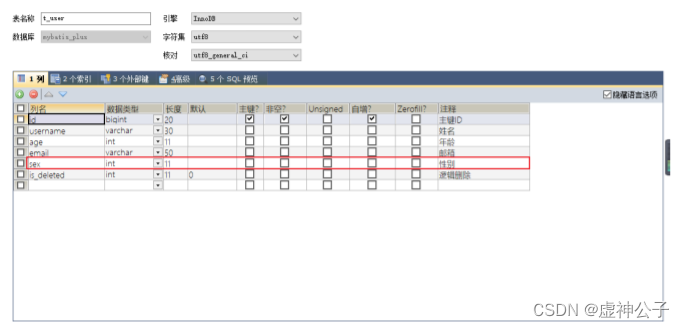
2、创建通用枚举类型
package com.xusheng.mybatisplus.enums;
import com.baomidou.mybatisplus.annotation.EnumValue;
import lombok.Getter;
@Getter
public enum SexEnum {
MALE(1, "男"),
FEMALE(2, "女");
@EnumValue //将注解所标识的属性的值存储到数据库中
private Integer sex;
private String sexName;
SexEnum(Integer sex, String sexName) {
this.sex = sex;
this.sexName = sexName;
}
}
3、配置扫描通用枚举
mybatis-plus:
configuration:
log-impl: org.apache.ibatis.logging.stdout.StdOutImpl
# 设置MyBatis-Plus的全局配置
global-config:
db-config:
# 设置实体类所对应的表的统一前缀
table-prefix: t_
# 设置统一的主键生成策略
id-type: auto
# 配置类型别名所对应的包
type-aliases-package: com.xusheng.mybatisplus.entity
# 扫描通用枚举的包
type-enums-package: com.xusheng.mybatisplus.enums
4、测试
package com.xusheng.mybatisplus;
import com.xusheng.mybatisplus.entity.User;
import com.xusheng.mybatisplus.enums.SexEnum;
import com.xusheng.mybatisplus.mapper.UserMapper;
import org.junit.jupiter.api.Test;
import org.springframework.beans.factory.annotation.Autowired;
import org.springframework.boot.test.context.SpringBootTest;
@SpringBootTest
public class MyBatisPlusEnumTest {
@Autowired
private UserMapper userMapper;
@Test
public void test(){
User user = new User();
user.setName("admin");
user.setAge(33);
//设置性别信息为枚举项,会将@EnumValue注解所标识的属性值存储到数据库
user.setSex(SexEnum.MALE);
//INSERT INTO t_user ( username, age, sex ) VALUES ( ?, ?, ? )
//Parameters: Enum(String), 20(Integer), 1(Integer)
int result = userMapper.insert(user);
System.out.println("result:"+result);
}
}
八、代码生成器
1、引入依赖
<dependency>
<groupId>com.baomidou</groupId>
<artifactId>mybatis-plus-generator</artifactId>
<version>3.5.1</version>
</dependency>
<dependency>
<groupId>org.freemarker</groupId>
<artifactId>freemarker</artifactId>
<version>2.3.31</version>
</dependency>
2、快速生成
package com.xusheng.mybatisplus;
import com.baomidou.mybatisplus.generator.FastAutoGenerator;
import com.baomidou.mybatisplus.generator.config.OutputFile;
import com.baomidou.mybatisplus.generator.engine.FreemarkerTemplateEngine;
import java.util.Collections;
/**
* Date:2022/2/15
* Author:xusheng
* Description:
*/
public class FastAutoGeneratorTest {
public static void main(String[] args) {
FastAutoGenerator.create("jdbc:mysql://127.0.0.1:3306/mybatis_plus?characterEncoding=utf-8&userSSL=false", "root", "root")
.globalConfig(builder -> {
builder.author("xusheng") // 设置作者
//.enableSwagger() // 开启 swagger 模式
.fileOverride() // 覆盖已生成文件
.outputDir("D://mybatis_plus"); // 指定输出目录
})
.packageConfig(builder -> {
builder.parent("com.xusheng") // 设置父包名
.moduleName("mybatisplus") // 设置父包模块名
.pathInfo(Collections.singletonMap(OutputFile.mapperXml, "D://mybatis_plus")); // 设置mapperXml生成路径
})
.strategyConfig(builder -> {
builder.addInclude("user") // 设置需要生成的表名
.addTablePrefix("t_", "c_"); // 设置过滤表前缀
})
.templateEngine(new FreemarkerTemplateEngine()) // 使用Freemarker引擎模板,默认的是Velocity引擎模板
.execute();
}
/*<dependency>
<groupId>com.baomidou</groupId>
<artifactId>mybatis-plus-generator</artifactId>
<version>3.5.1</version>
</dependency>
<dependency>
<groupId>org.freemarker</groupId>
<artifactId>freemarker</artifactId>
<version>2.3.31</version>
</dependency>*/
}
九、多数据源
适用于多种场景:纯粹多库、 读写分离、 一主多从、 混合模式等
目前我们就来模拟一个纯粹多库的一个场景,其他场景类似
场景说明:
我们创建两个库,分别为:mybatis_plus(以前的库不动)与mybatis_plus_1(新建),将mybatis_plus库的product表移动到mybatis_plus_1库,这样每个库一张表,通过一个测试用例
分别获取用户数据与商品数据,如果获取到说明多库模拟成功
1、创建数据库及表
创建数据库mybatis_plus_1和表product
CREATE DATABASE `mybatis_plus_1` /*!40100 DEFAULT CHARACTER SET utf8mb4 */;
use `mybatis_plus_1`;
CREATE TABLE product
(
id BIGINT(20) NOT NULL COMMENT '主键ID',
name VARCHAR(30) NULL DEFAULT NULL COMMENT '商品名称',
price INT(11) DEFAULT 0 COMMENT '价格',
version INT(11) DEFAULT 0 COMMENT '乐观锁版本号',
PRIMARY KEY (id)
);
添加测试数据
INSERT INTO product (id, NAME, price) VALUES (1, '外星人笔记本', 100);
删除mybatis_plus库product表
use mybatis_plus;
DROP TABLE IF EXISTS product;
2、引入依赖
<dependency>
<groupId>com.baomidou</groupId>
<artifactId>dynamic-datasource-spring-boot-starter</artifactId>
<version>3.5.0</version>
</dependency>
3、配置多数据源
说明:注释掉之前的数据库连接,添加新配置
spring:
# 配置数据源信息
datasource:
dynamic:
# 设置默认的数据源或者数据源组,默认值即为master
primary: master
# 严格匹配数据源,默认false.true未匹配到指定数据源时抛异常,false使用默认数据源
strict: false
datasource:
master:
url: jdbc:mysql://localhost:3306/mybatis_plus1?characterEncoding=utf-8&useSSL=false
driver-class-name: com.mysql.cj.jdbc.Driver
username: root
password: root
slave_1:
url: jdbc:mysql://localhost:3306/mybatis_plus_1?characterEncoding=utf-8&useSSL=false
driver-class-name: com.mysql.cj.jdbc.Driver
username: root
password: root
4、创建用户service
package com.xusheng.mybatisplus.service;
import com.xusheng.mybatisplus.entity.User;
import com.baomidou.mybatisplus.extension.service.IService;
/**
* <p>
* 服务类
* </p>
*
* @author xusheng
* @since 2023-04-04
*/
public interface UserService extends IService<User> {
}
package com.xusheng.mybatisplus.service.impl;
import com.baomidou.dynamic.datasource.annotation.DS;
import com.xusheng.mybatisplus.entity.User;
import com.xusheng.mybatisplus.mapper.UserMapper;
import com.xusheng.mybatisplus.service.UserService;
import com.baomidou.mybatisplus.extension.service.impl.ServiceImpl;
import org.springframework.stereotype.Service;
/**
* <p>
* 服务实现类
* </p>
*
* @author xusheng
* @since 2023-04-04
*/
@Service
@DS("master")
public class UserServiceImpl extends ServiceImpl<UserMapper, User> implements UserService {
}
5、创建商品service
package com.xusheng.mybatisplus.service;
import com.xusheng.mybatisplus.entity.Product;
import com.baomidou.mybatisplus.extension.service.IService;
/**
* <p>
* 服务类
* </p>
*
* @author xusheng
* @since 2023-04-04
*/
public interface ProductService extends IService<Product> {
}
package com.xusheng.mybatisplus.service.impl;
import com.baomidou.dynamic.datasource.annotation.DS;
import com.xusheng.mybatisplus.entity.Product;
import com.xusheng.mybatisplus.mapper.ProductMapper;
import com.xusheng.mybatisplus.service.ProductService;
import com.baomidou.mybatisplus.extension.service.impl.ServiceImpl;
import org.springframework.stereotype.Service;
/**
* <p>
* 服务实现类
* </p>
*
* @author xusheng
* @since 2023-04-04
*/
@Service
@DS("slave_1")
public class ProductServiceImpl extends ServiceImpl<ProductMapper, Product> implements ProductService {
}
6、测试
package com.xusheng.mybatisplus;
import com.xusheng.mybatisplus.service.ProductService;
import com.xusheng.mybatisplus.service.UserService;
import org.junit.jupiter.api.Test;
import org.springframework.beans.factory.annotation.Autowired;
import org.springframework.boot.test.context.SpringBootTest;
@SpringBootTest
class MybatisPlusDatasourceApplicationTests {
@Test
void contextLoads() {
}
@Autowired
private UserService userService;
@Autowired
private ProductService productService;
@Test
public void test(){
System.out.println(userService.getById(1));
System.out.println(productService.getById(1));
}
}
结果:
1、都能顺利获取对象,则测试成功
2、如果我们实现读写分离,将写操作方法加上主库数据源,读操作方法加上从库数据源,自动切换,是不是就能实现读写分离?
十、MyBatisX插件
MyBatis-Plus为我们提供了强大的mapper和service模板,能够大大的提高开发效率;
但是在真正开发过程中,MyBatis-Plus并不能为我们解决所有问题,例如一些复杂的SQL,多表联查,我们就需要自己去编写代码和SQL语句,我们该如何快速的解决这个问题呢,这个时候可以使用MyBatisX插件;
MyBatisX一款基于 IDEA 的快速开发插件,为效率而生。
MyBatisX插件用法:https://baomidou.com/pages/ba5b24/




